Catalog Ads for Multi-brand stores and retailers
October 14, 2024
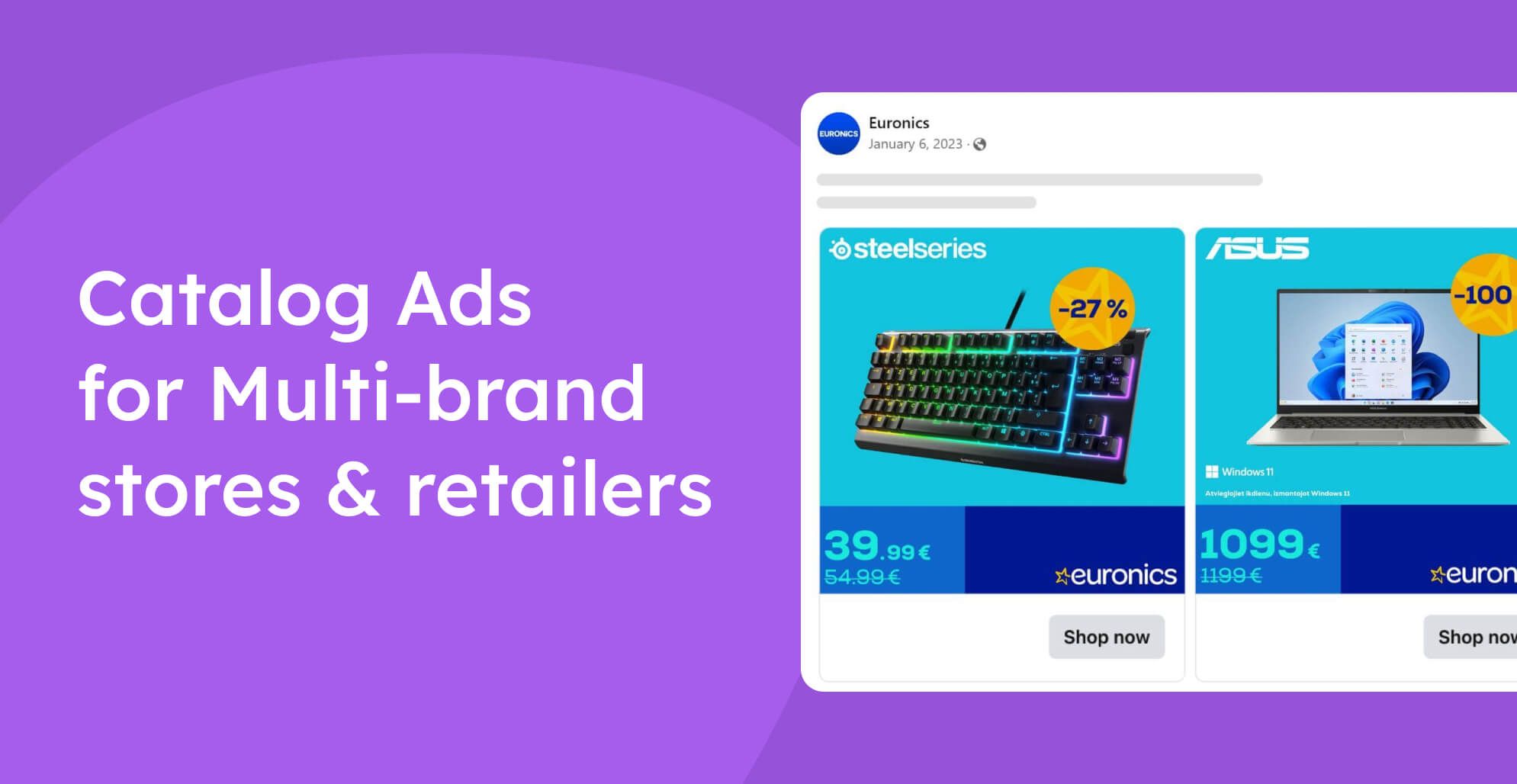
Catalog Ads is a powerful opportunity to showcase your products strategically and visually. For multi-brand stores and retailers it becomes even more exciting as it allows them to curate an experience similar to how they carefully selected their product range.
Bookmark this page by pressing ctrl + D / cmd + D, or by clicking the star icon in your URL bar ⭐️.
After all, multi-brand stores play a unique and valuable role in the shopping experience. They’re seen as trusted advisors. They can offer a broader, more objective view of a product category to help consumers compare options and pick the best product in the industry for their needs. Individual brands, on the other hand, have to focus solely on promoting their own products.
To help you create high-performing ads that showcase your wide product range without overwhelming your target market, here’s data about which designs consistently drive performance for multi-brand stores and retailers. All the numbers that we share show how Catalog Ads perform on average compared to Catalog Ads without that specific product field.
Here you have the insights in a quick cheat sheet - click to get more details:
The most used product fields in Catalog Ads designs:
The moderately used product fields in Catalog Ads designs:
The rarely used product fields in Catalog Ads designs:
Showing Prices in your Catalog Ads
Even though prices are effective for brands themselves, multi-brand retailers see the biggest improvement in performance when showing prices in their Catalog Ads.
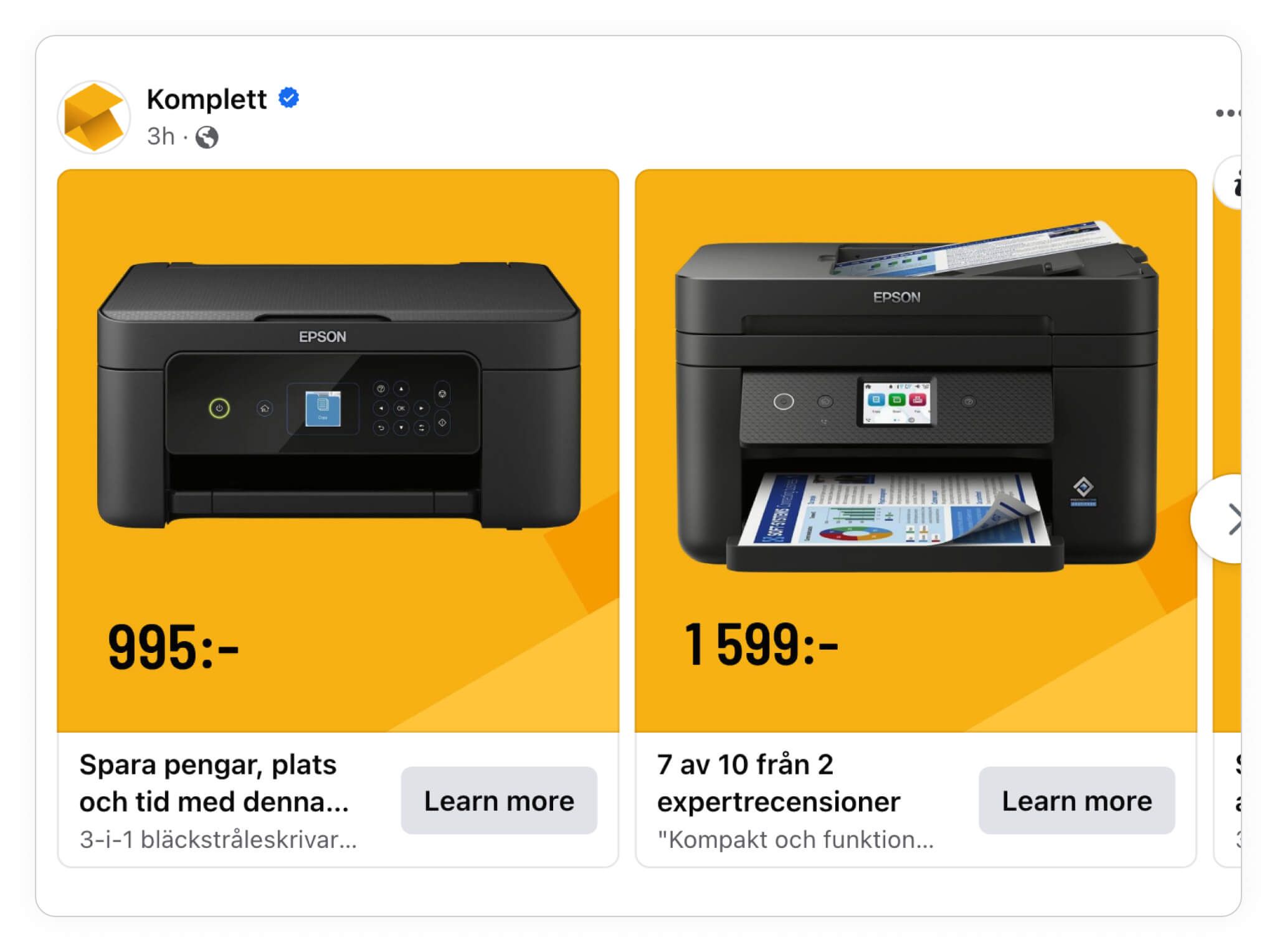
- Brands and DTC companies see a +25% improvement in Return on Ad Spend when showing prices
- Multi-brand stores see a +56% improvement in Return on Ad Spend when showing prices
It can be especially effective for mid-range or budget-friendly multi-brand stores as showing competitive prices can reinforce their value-for-money image. Price-conscious shoppers like to compare prices across brands and displaying the prices will let you unlock the full value of stocking various brands.
Other than reinforcing the store’s positioning, it can also help multi-brand stores to build trust and transparency. Even if you're selling high-end, luxurious brands, consumers appreciate clarity with regards to pricing. It signals honesty.
Plus, it also reduces friction in the customer journey. With the price placed prominently in the ad, they have to click through fewer steps just to see if it fits their budget.
Here's how showing prices on average influence Catalog Ads:
Return On Ad Spend
+56%
Cost Per Purchase
+0%
Click Through Rate
-10%
Cost Per Click
+23%
Conversion Rate
+14%
Usage
58%
These numbers show how Catalog Ads showing prices perform on average compared to Catalog Ads not showing prices.
Remember that these are average numbers. For some brands, prices perform better, and for other brands, prices perform worse.
You can learn more about showing prices in your Catalog Ads right here.
Showing your Logo in Catalog Ads

Here's how showing your logo on average influence Catalog Ads:
Return On Ad Spend
+14%
Cost Per Purchase
-17%
Click Through Rate
+3%
Cost Per Click
+6%
Conversion Rate
+11%
Usage
39%
These numbers show how Catalog Ads showing the logo of the advertiser perform on average compared to Catalog Ads not showing the logo.
Remember that these are average numbers. For some brands, their logo perform better, and for other brands, their logo perform worse.
While displaying logos don’t have such a massive impact on metrics like your return on ad spend or conversion rate, they’re still powerful. Logos serve as visual shortcuts. What’s more, if you’re selling well-known brands, these logos will be instantly recognizable. Shoppers can immediately identify their preferred brands without needing to read through text. Brand-loyal customers are also more likely to engage with a catalog if they see the logos of the brands they already trust and prefer.
When shoppers aren’t buying directly from the brand’s official store, they’re looking for trust signals that indicate that they are indeed buying the real deal. Logos can offer this extra layer of credibility.
Aside from credibility, it can also improve your perceived value. If your store is linked with reputable brands’ logos, you’ll be seen as a more premium place to shop.
Showing On-sale designs in your Catalog Ads
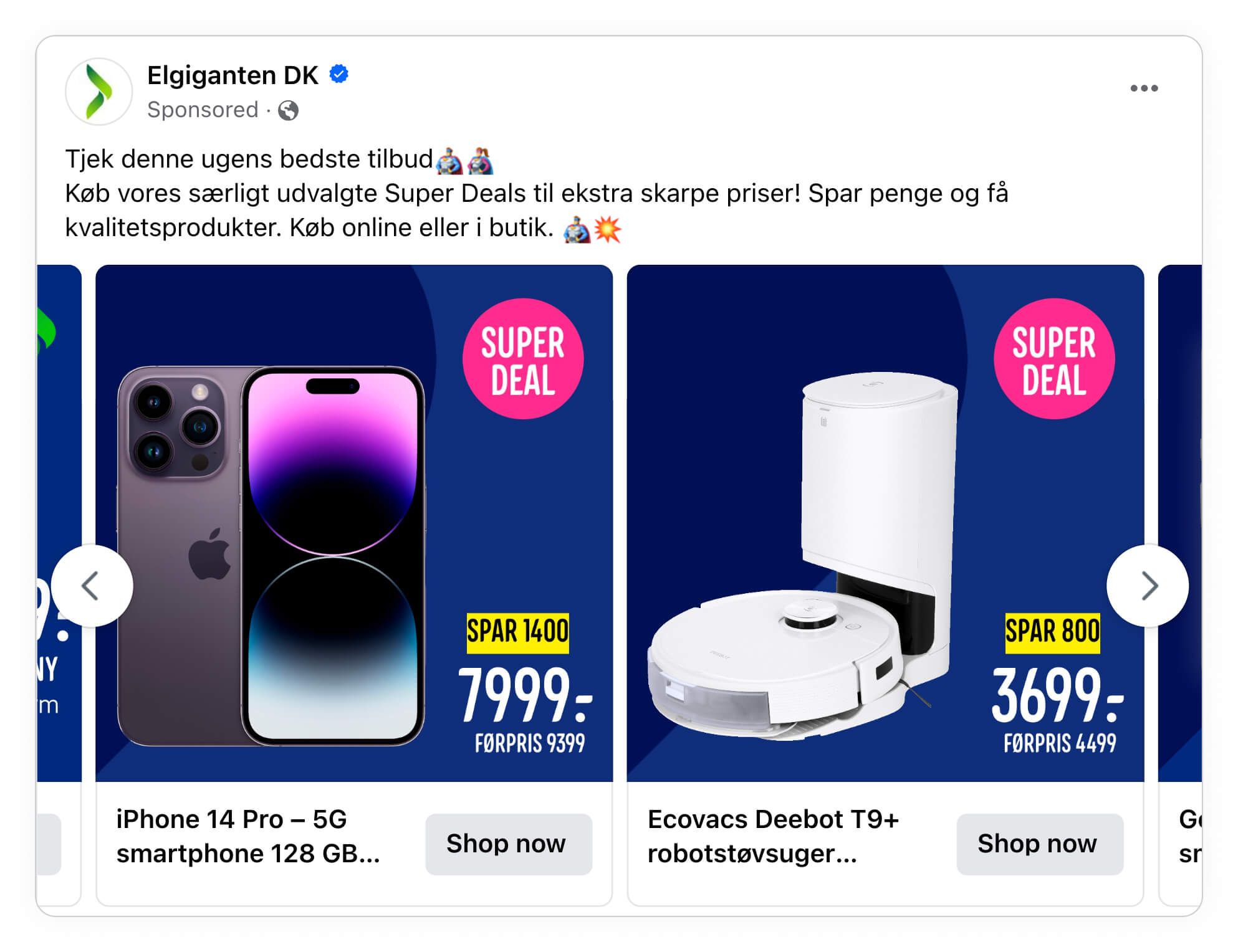
Here's how showing on-sale designs on average influence Catalog Ads:
Return On Ad Spend
+47%
Cost Per Purchase
-10%
Click Through Rate
-3%
Cost Per Click
+6%
Conversion Rate
+19%
Usage
46%
These numbers show how Catalog Ads showing on-sale designs perform on average compared to Catalog Ads not showing on-sale designs.
Remember that these are average numbers. For some brands, on-sale designs perform better, and for other brands, on-sale designs perform worse.
Sale tags, price slashes and other on-sale designs are examples of how you can use the power of marketing psychology. It triggers a fear among your target audience that they’ll miss out which creates urgency to act fast. Not only that, on-sale designs are generally more striking visually, helping to communicate value quickly when you have a crowded layout with multiple brands.
Multi-brand stores can use it to highlight price drops, for example, making it easier for customers to spot deals and compare savings. Plus, if you choose to reduce the price of lesser-known brands, it offers the added benefit of leveling the playing field between major, global brands and emerging ones.
Plus, as they’ll be saving money, it can often encourage your target audience to explore some of the other brands that you stock. They might check out with only one branded product now, but as they will feel like they received a better deal they’re likely to return to check out your other brands too.
Showing Product Names in your Catalog Ads
Showing names and titles of products works best for multi-brand stores, which often sell many more different products compared to the brands themselves.
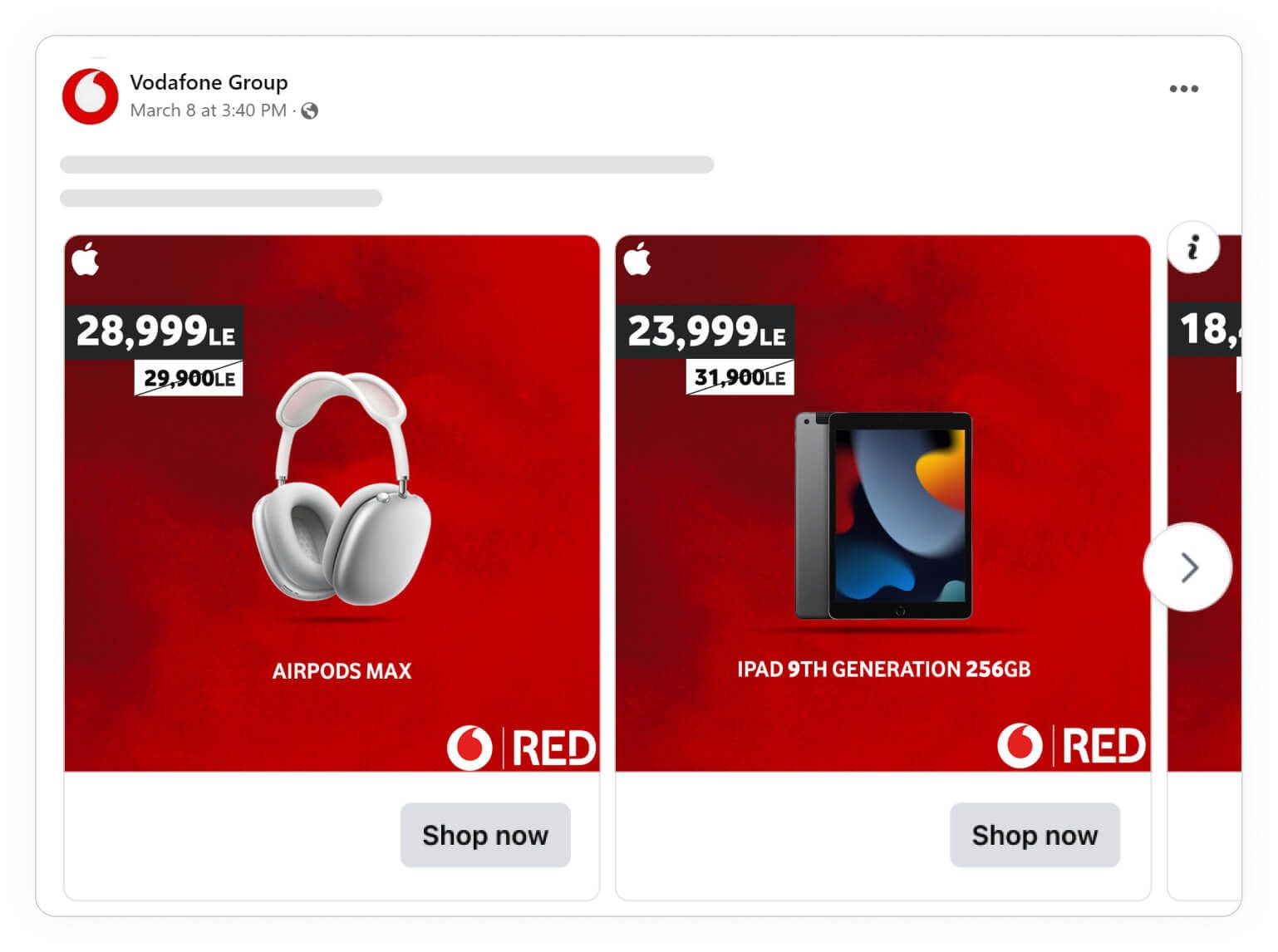
- Brands and DTC companies see a +11% improvement in Return on Ad Spend when showing product names
- Multi-brand stores see a +31% improvement in Return on Ad Spend when showing product names
You can learn more about showing product names in your Catalog Ads right here.
Here's how showing product names on average influence Catalog Ads:
Return On Ad Spend
+31%
Cost Per Purchase
-12%
Click Through Rate
-5%
Cost Per Click
+8%
Conversion Rate
+23%
Usage
39%
These numbers show how Catalog Ads showing product names perform on average compared to Catalog Ads not showing product names.
Remember that these are average numbers. For some brands, product names perform better, and for other brands, product names perform worse.
This uplift can be explained by the fact that product names offer clarity. When you’re selling different brands, there might be several products that look alike. Displaying the product name will help shoppers to tell them clearly apart.
Plus, when a customer has a specific mode, style or version in mind, this extra info makes it easy for them to confirm it’s the right item. Even if a customer is still in the exploration phase, product names can share helpful details like specs or features.
You can learn more about showing product names in your Catalog Ads right here.
Showing Original prices in your Catalog Ads
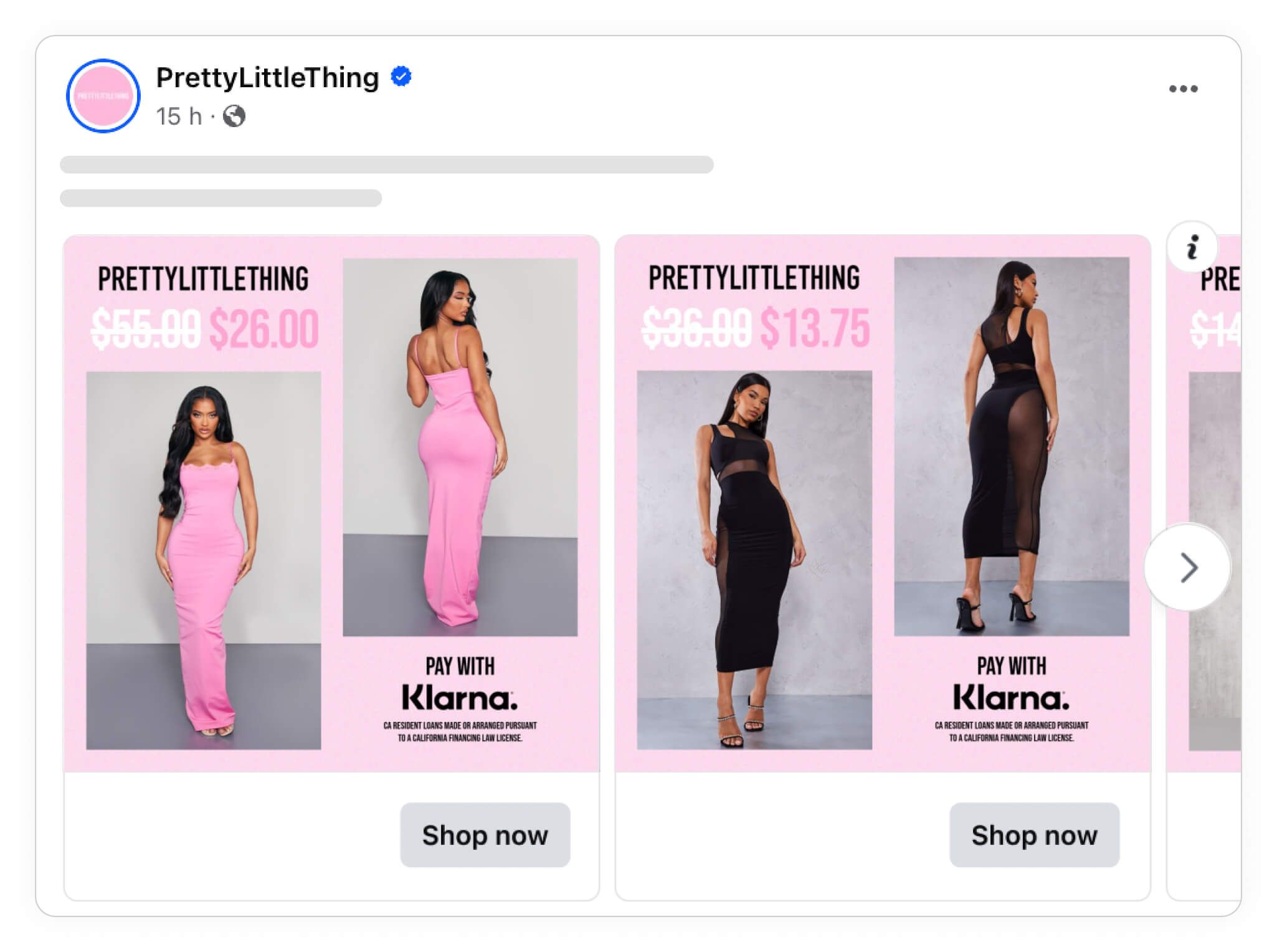
Here's how showing original prices on average influence Catalog Ads:
Return On Ad Spend
+16%
Cost Per Purchase
+1%
Click Through Rate
-7%
Cost Per Click
+7%
Conversion Rate
-5%
Usage
28%
These numbers show how Catalog Ads showing original prices perform on average compared to Catalog Ads not showing original prices.
Remember that these are average numbers. For some brands, original prices perform better, and for other brands, original prices perform worse.
Including the original prices in your Catalog Ads makes cross-brand comparison easier. Shoppers can use this extra info to compare value across different brands which helps decision-making.
It can also communicate the premium status or quality of the branded product. After all, a higher original price is often used as an indication that you're buying a better product.
That said, as seen from our data, it can hurt your conversion and click-through rate (CTR). A possible explanation for this trend is that it can confuse shoppers. Multi-brand stores often feature products with different pricing models (for example, premium vs budget brands). Showing both original and sale prices can overwhelm users with too many numbers.
Showing additional images in your Catalog Ads
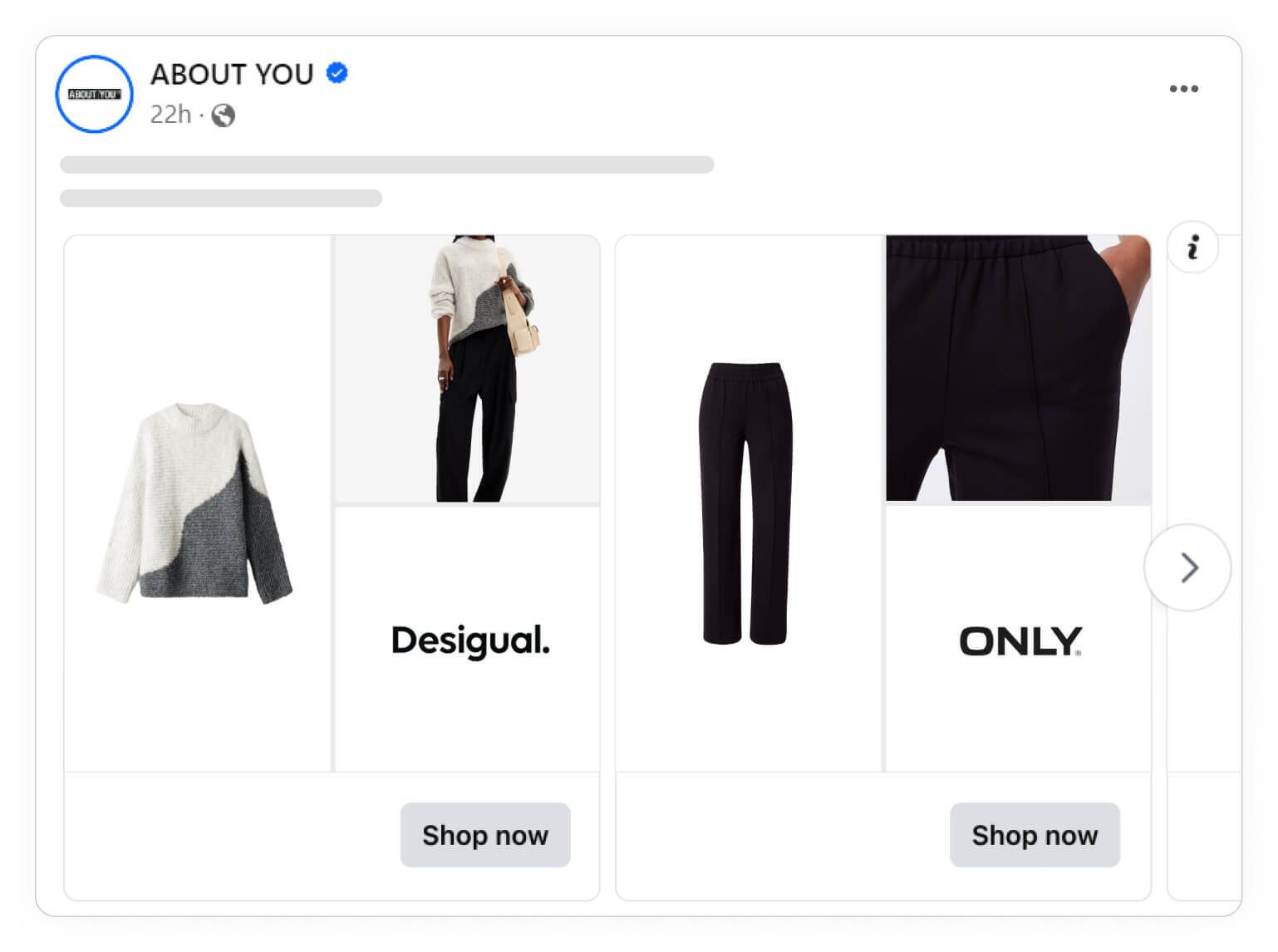
Most consumers base their buying decisions on visuals. Making space for more images in your ads makes it easier for them to connect with a product emotionally.
It’s also key when you’re selling similar products but from different brands. You can, for example, use secondary images to spotlight specific features and selling points like texture or fit that may not be visible in the main shot.
If it can enhance product understanding, you can justify adding more images. On the other hand, if an extra image will confuse more than clarify, rather use the space for another element.
Here's how showing additional images on average influence Catalog Ads:
Return On Ad Spend
+29%
Cost Per Purchase
+2%
Click Through Rate
+0%
Cost Per Click
+7%
Conversion Rate
+15%
Usage
17%
These numbers show how Catalog Ads showing additional images perform on average compared to Catalog Ads not showing additional images.
Remember that these are average numbers. For some brands, additional images perform better, and for other brands, additional images perform worse.
You can learn more about Additional images in Dynamic Product Ads right here.
Showing Savings and Discounts in your Catalog Ads
Savings and discounts are almost always good ways to make people buy, but it's interesting how they’re a bit more effective for the brands themselves than for multi-brand stores.
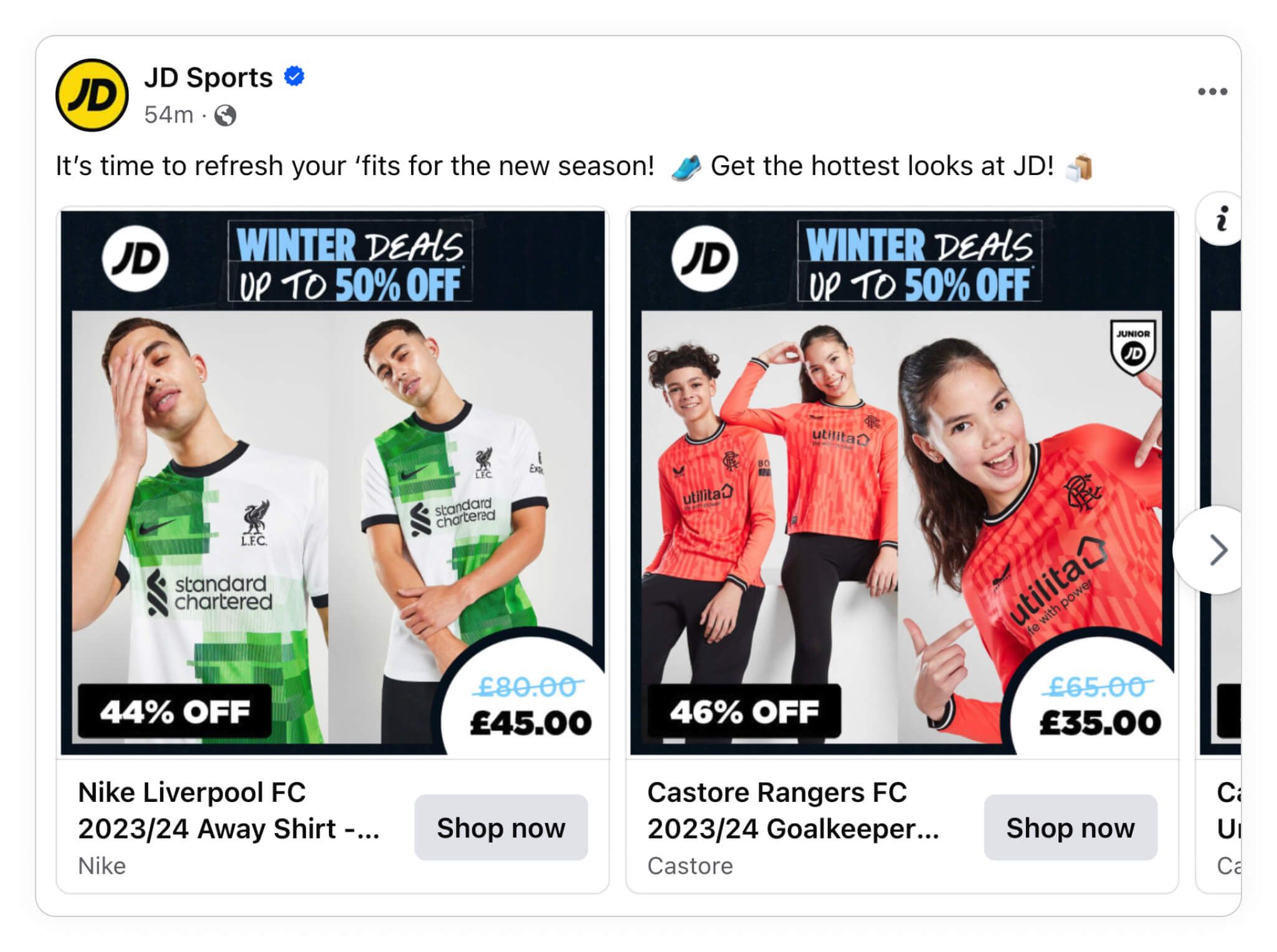
- Brands and DTC companies see a +73% improvement in Return on Ad Spend when showing savings and discounts
- Multi-brand stores see a +54% improvement in Return on Ad Spend when showing savings and discounts
That said, it can still be an effective sales strategy for multi-brand stores. It can be used to build a competitive advantage. Perhaps the brand itself isn’t currently running a discount? When they are, they might not show their discounts as clearly, helping your store to stand out.
In fact, in addition to convenience, another main reason why consumers will choose a multi-brand store over a specific brand’s own store is price. Highlighting savings and discounts supports strategic pricing positioning and communicates to your target audience that you’re value-driven.
Another advantage for multi-brand stores with a large and varied catalog is that it can increase engagement. When shoppers see noteworthy savings, they’re more likely to browse deeper and discover other brands.
We have deep-dived into sales and campaigns in Dynamic Product Ads here if you are interested.
Here's how showing savings on average influence Catalog Ads:
Return On Ad Spend
+54%
Cost Per Purchase
-2%
Click Through Rate
+2%
Cost Per Click
-2%
Conversion Rate
+17%
Usage
29%
These numbers show how Catalog Ads showing savings perform on average compared to Catalog Ads not showing savings.
Remember that these are average numbers. For some brands, savings perform better, and for other brands, savings perform worse.
You can learn more about showing savings and discounts in your Catalog Ads here.
Showing Dates in your Catalog Ads
Dates are especially effective for multi-brand stores.
- Brands and DTC companies, on average, don't see improvements in Return on Ad Spend when showing dates
- Multi-brand stores see a +49% improvement in Return on Ad Spend when showing dates
Here's how showing dates on average influence Catalog Ads:
Return On Ad Spend
+49%
Cost Per Purchase
-23%
Click Through Rate
-1%
Cost Per Click
+17%
Conversion Rate
+30%
Usage
15%
These numbers show how Catalog Ads showing dates perform on average compared to Catalog Ads not showing dates.
Remember that these are average numbers. For some brands, dates perform better, and for other brands, dates perform worse.
Including a date is one of the most effective ways to create urgency among consumers. Combine it with a sale that’s about to start or end soon and your target audience has even more reason to take action immediately. Hence, why a simple date has shown to improve conversion rate by as much as 30%.
It also helps with relevancy. Even multi-brand stores and retailers can’t stock all the brands! It calls for careful curation and showing a date in your Catalog Ads can communicate that you’re selling current trends. It implies active management of your product catalog, which is key if you’re selling various brands.
Then, when it becomes a regular ad strategy, it can encourage return visits. When new customers notice dates change over time, they have another reason to return to check out updates to your product range, particularly helpful for multi-brand stores with dynamic inventories.
Highlighting News in your Catalog Ads
Here's how highlighting news on average influence Catalog Ads:
Return On Ad Spend
+2%
Cost Per Purchase
-6%
Click Through Rate
+15%
Cost Per Click
-9%
Conversion Rate
-12%
Usage
14%
These numbers show how Catalog Ads highlighting news perform on average compared to Catalog Ads not highlighting news.
Remember that these are average numbers. For some brands, highlighting news perform better, and for other brands, highlighting news perform worse.
You’ll notice that compared to other elements like price, including the word “new” has a minor effect on your return on ad spend. Its impact on your click-through rate is better which can be explained by the fact that it stirs curiosity. Brand loyalists are naturally curious about what their favorite brand has recently added. Just take the countdown and turnout to Apple events as an example.
That said, this advertising strategy not only appeals to brand-loyal shoppers. The word “new” also signals to other shoppers that fresh inventory has been added since their last visit.
It creates the perception among all members of your target market that you’re relevant and offer value. This builds trust and encourages repeat visits.
Showing Shipping info in your Catalog Ads
It’s rare to see shipping information improving the performance of Catalog Ads, but when looking at shop types, we actually see a big difference:
Brands and DTC companies see a 38% decrease in return on ad spend when showing shipping information.
Multi-brand stores, on the other hand, see a 11% improvement in return on ad spend when showing shipping details.
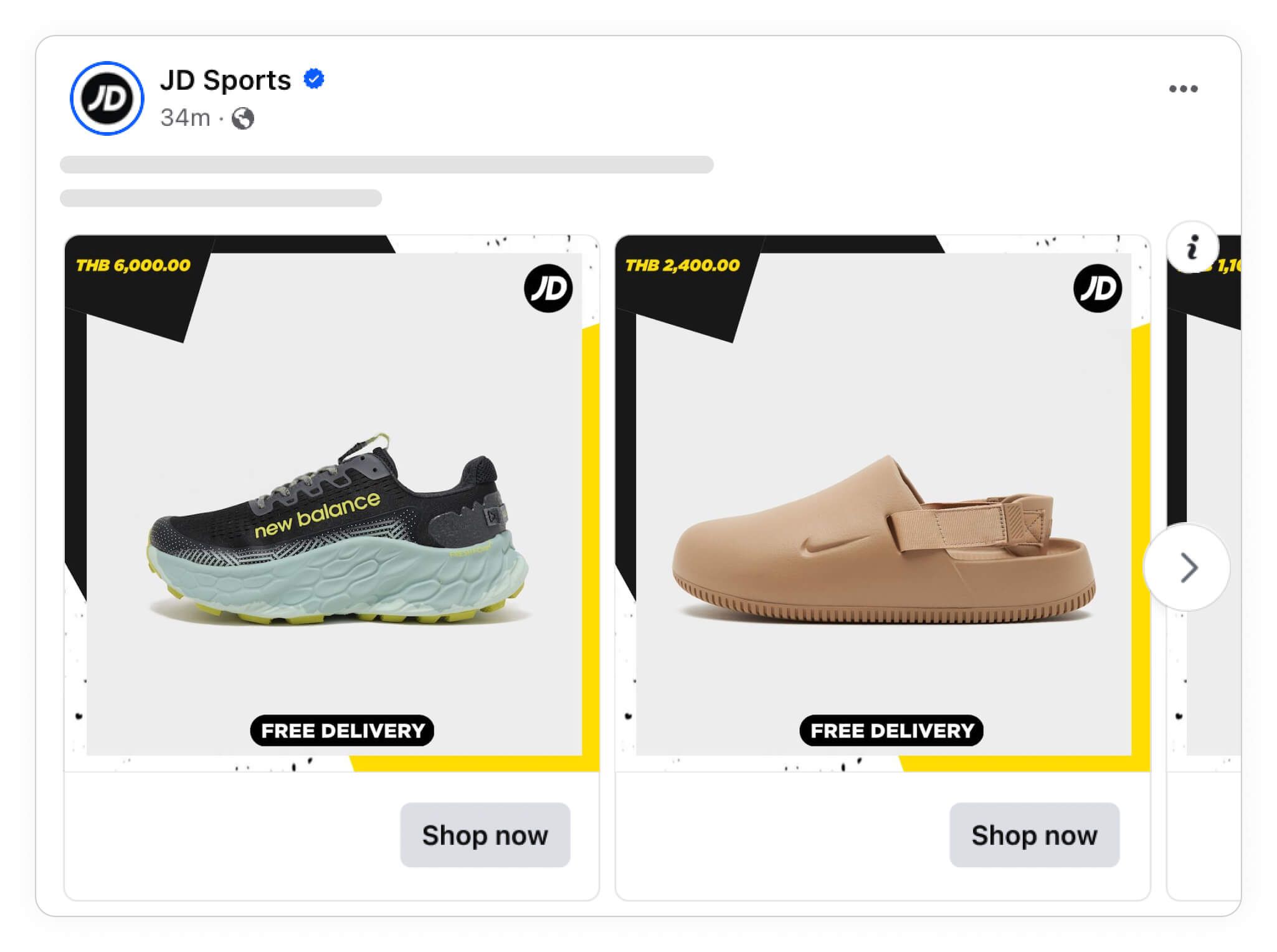
Customers don’t care about shipping information from brands themselves, whereas multi-brand stores might benefit from telling customers in the ads directly. Brands and DTC companies should talk more about themselves and their products, not about shipping information, which is likely the same for other brands.
After all, one of the major benefits that a multi-brand retailer offers is the convenience of delivering items from different popular brands as one package. As you’re typically competing on your shipping perks, it’s a detail that you want to highlight.
Consistent shipping info in ads also helps customers feel confident they’ll get a reliable service, regardless of the brand they’re purchasing.
Here's how showing shipping info on average influence Catalog Ads:
Return On Ad Spend
+11%
Cost Per Purchase
-34%
Click Through Rate
-6%
Cost Per Click
-12%
Conversion Rate
+33%
Usage
17%
These numbers show how Catalog Ads showing shipping information perform on average compared to Catalog Ads not showing shipping information.
Remember that these are average numbers. For some brands, shipping info perform better, and for other brands, shipping info perform worse.
Using Product Assets in your Catalog Ads
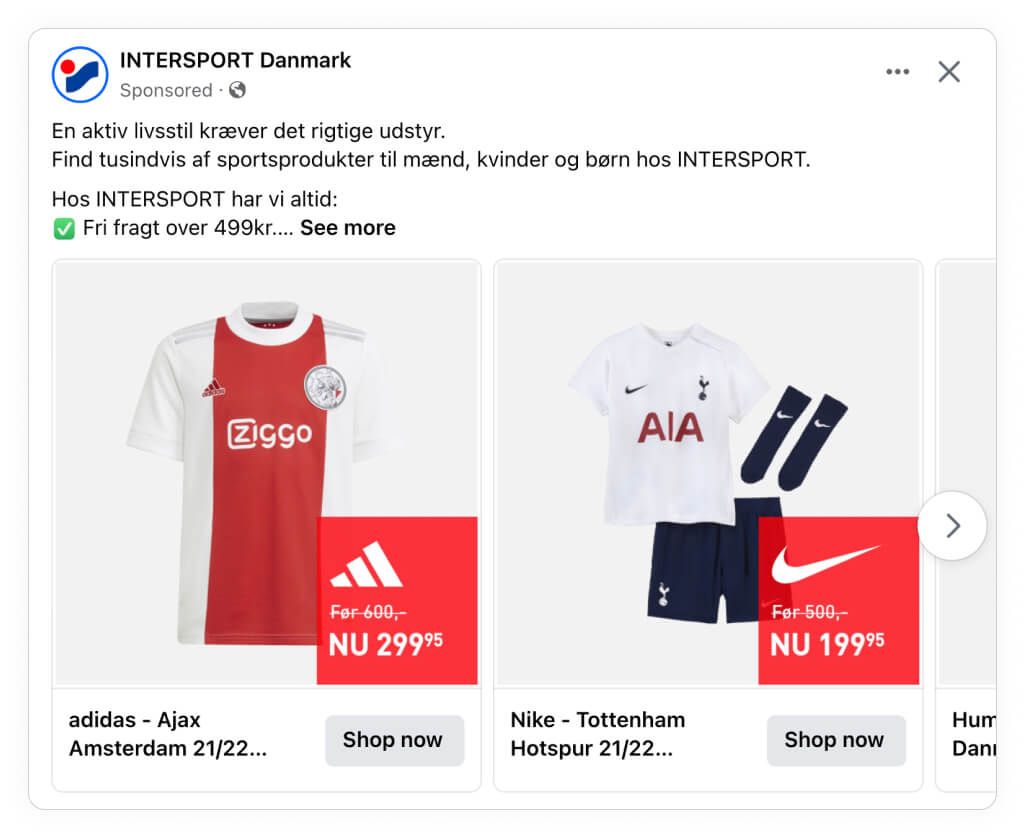
Here's how showing product assets on average influence Catalog Ads:
Return On Ad Spend
+55%
Cost Per Purchase
-45%
Click Through Rate
+5%
Cost Per Click
-2%
Conversion Rate
-0%
Usage
21%
These numbers show how Catalog Ads showing product assets perform on average compared to Catalog Ads not showing product assets.
Remember that these are average numbers. For some brands, product assets perform better, and for other brands, product assets perform worse.
As it can significantly increase your return on ad spend and slash your cost per purchase, you’ll want to use a tool like Confect lets you add product assets easily. You can, for example, use it to change the product image based on information such as the country of origin or energy efficiency rating.
Multi-brand stores benefit from variety, making this a good tactic that you can use. This way, you can let different brands shine in their own way, while maintaining overall visual consistency.
Showing Social Proof in your Catalog Ads
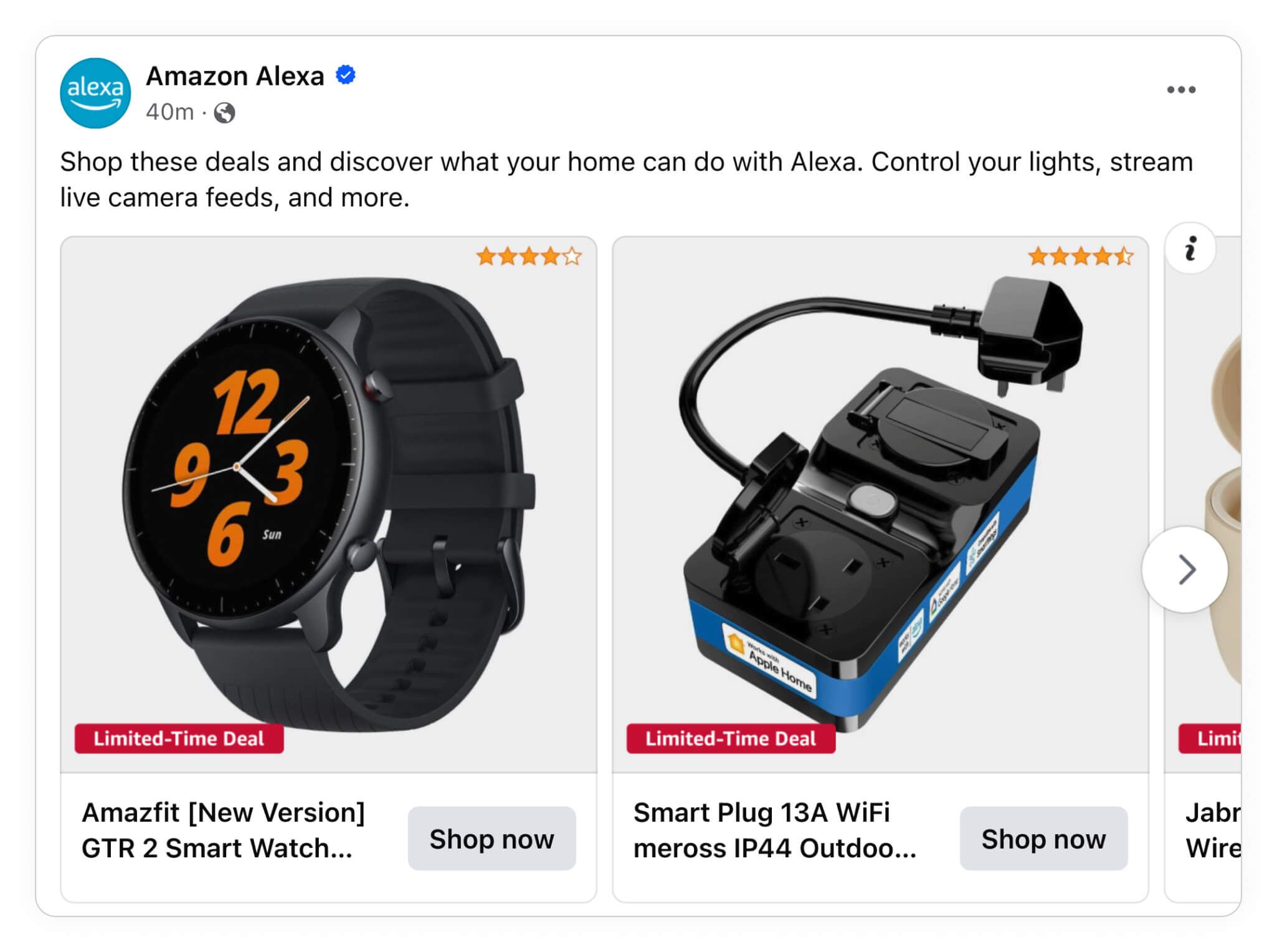
Here's how showing social proof on average influence Catalog Ads:
Return On Ad Spend
+39%
Cost Per Purchase
-27%
Click Through Rate
-13%
Cost Per Click
+14%
Conversion Rate
+66%
Usage
10%
These numbers show how Catalog Ads showing social proof perform on average compared to Catalog Ads not showing social proof.
Remember that these are average numbers. For some brands, social proof perform better, and for other brands, social proof perform worse.
If you’re asking brand-loyal customers to shop from your store instead of the brand’s own store, you need to provide them with proof that you’re trustworthy. The fact that you’re selling various well-known brands at comparable prices (if not cheaper) may be perceived as too good to be true and new customers will want to see that your store is legit.
Aside from using social proof to build trust in your store, it also helps highlight credibility across multiple brands. If you carry both well-known and niche brands, reviews or ratings will make the lesser-known brands more credible. It’s an alternative to brand recognition and essentially tells new customers that others have bought and liked the product.
Showing Product Brands in your Catalog Ads
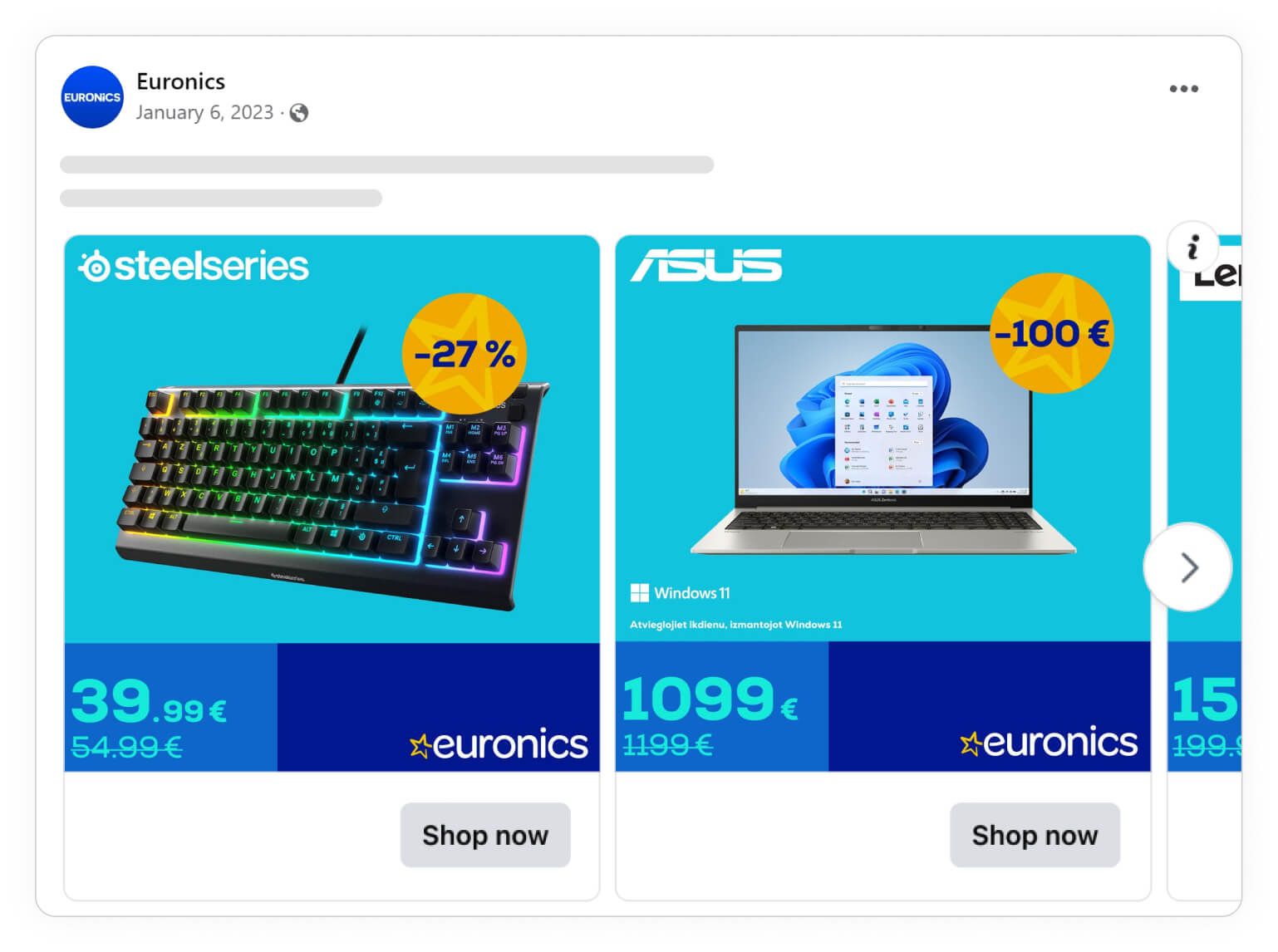
Here's how showing brand names on average influence Catalog Ads:
Return On Ad Spend
+6%
Cost Per Purchase
+15%
Click Through Rate
+9%
Cost Per Click
-3%
Conversion Rate
-30%
Usage
17%
These numbers show how Catalog Ads showing brand names perform on average compared to Catalog Ads not showing brand names.
Remember that these are average numbers. For some retailers, brand names perform better, and for other retailers, brand names perform worse.
The significant decrease it can have on your conversion rate, isn’t necessarily worth the single-digit gains you’ll make in return on ad spend and conversion rate. When creating your Catalog Ads, don’t assume that shoppers care about a specific brand. They’re more likely shopping from a multi-brand retailer because they’re looking for a variety.
Plus, it’s an advertising strategy that you’ll have difficulty pulling off successfully for unknown brands. If you display a brand name that fewer consumers know, they’ll likely ignore the ad entirely even if the product is great or offers good value.
Showing Custom_labels in your Catalog Ads
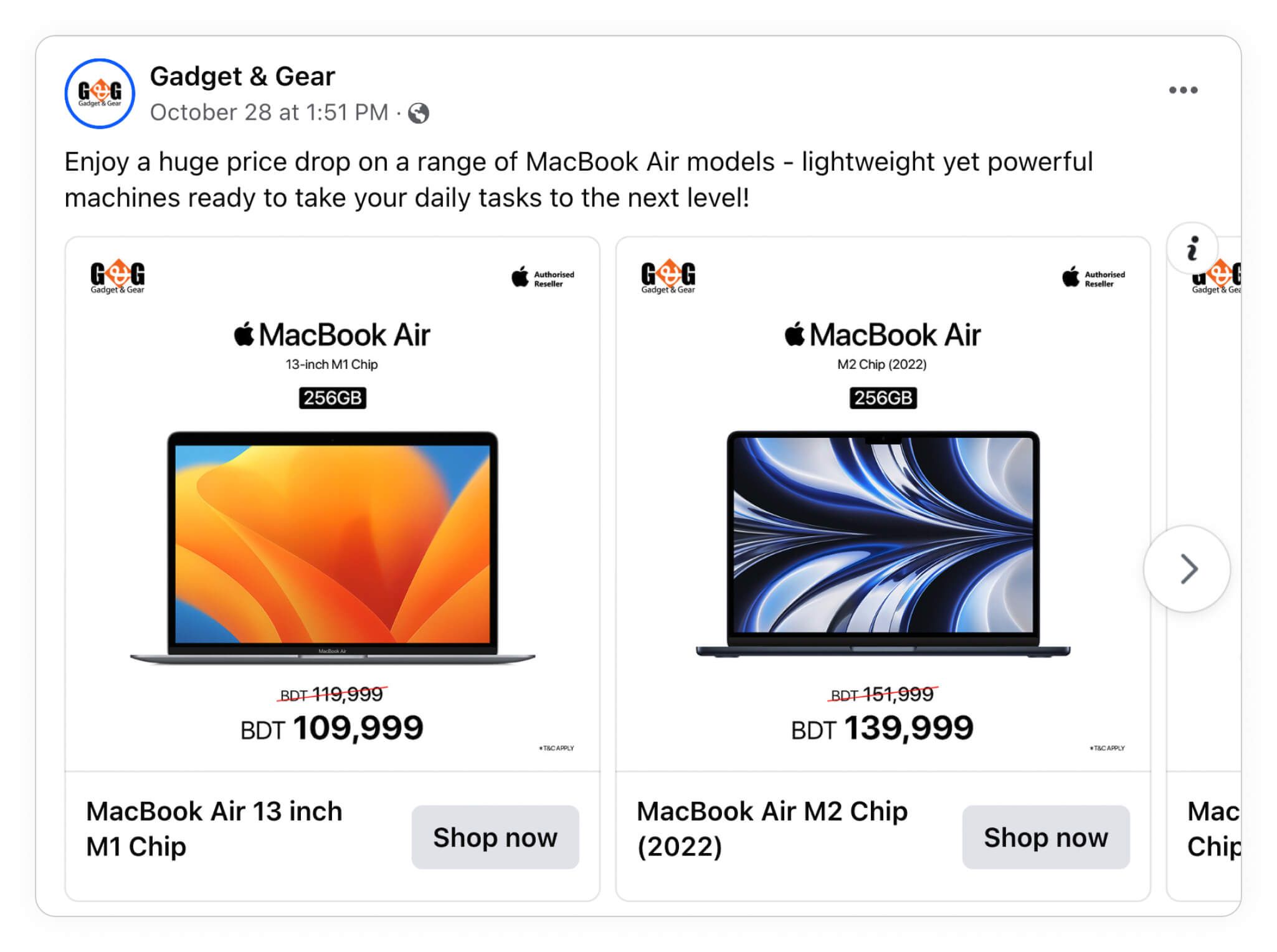
Here's how showing custom labels on average influence Catalog Ads:
Return On Ad Spend
+84%
Cost Per Purchase
+27%
Click Through Rate
-17%
Cost Per Click
+23%
Conversion Rate
+52%
Usage
8%
These numbers show how Catalog Ads showing custom labels perform on average compared to Catalog Ads not showing custom labels.
Remember that these are average numbers. For some brands, custom labels perform better, and for other brands, custom labels perform worse.
Custom labels offer flexibility that’s essential for managing large, diverse inventories. In a multi-brand store, customers may not know where to start. Custom labels help organize and surface products based on what people are likely to care about, rather than forcing them to filter manually.
You can use it to tag bestsellers or new arrivals, for example. What makes a custom label like “bestseller” such a powerful strategy is that it doubles up as a way to include social proof too. With a single word, you can group products from various brands together and communicate to shoppers that they can put their trust in any of these brands.
Showing Categories in your Catalog Ads
You’ll need another way other than brand name to organize your product range that likely includes thousands of SKUs across different industries. Category labels act like a map to help shoppers navigate their way around your broad catalog. It helps to reduce choice overload letting your variety remain a reason to shop from your store.
After all, not all customers are brand loyalists and are open to other manufacturers when they’re in the market for men’s shoes or tech accessories, for example. It’s a simple strategy that can have a significant positive impact on certain key metrics like return on ad spend and conversion rate.
Here's how showing product categories on average influence Catalog Ads:
Return On Ad Spend
+131%
Cost Per Purchase
-53%
Click Through Rate
-37%
Cost Per Click
+50%
Conversion Rate
+232%
Usage
3%
These numbers show how Catalog Ads showing categories perform on average compared to Catalog Ads not showing categories.
Remember that these are average numbers. For some brands, categories perform better, and for other brands, categories perform worse.
Showing Product Descriptions in Catalog Ads
Here's how showing descriptions on average influence Catalog Ads:
Return On Ad Spend
+8%
Cost Per Purchase
+47%
Click Through Rate
-31%
Cost Per Click
+17%
Conversion Rate
-46%
Usage
0%
These numbers show how Catalog Ads showing descriptions perform on average compared to Catalog Ads not showing descriptions.
Remember that these are average numbers. For some brands, descriptions perform better, and for other brands, descriptions perform worse.
Compared to other elements, adding product descriptions to your Catalog Ads when you sell multiple brands will do more harm than good. The most logical reason for this trend is that product descriptions can add clutter.
It can also detract the attention from other key elements like price or ratings that consumers use to choose between two different brands. Rather use additional high-quality photos to explain your product so that the words that stand out are phrases like “new technology” or “free shipping” that have a more positive impact on consumer behaviour.
Final thoughts
For your Catalog Ads to be effective, focus on the product fields that help to show the advantages that you offer over shopping from the brand’s own store. While it might come as a surprise, your target audience will likely carry less about the brand itself. They want to see the price and that your catalog is fresh. Your store shouldn’t just be a place where brands can dump their old stock.
Just like there’s a long list of brands that sell essentially the same product, there are various elements that you use to generate comparable results. For example, price, product assets, and discounts can improve your return on ad spend by more than 50%. In fact, custom labels and categories can improve it by more than double that. Imagine what type of results you can achieve when you combine, for example, product categories with savings by creating Catalog ads around men’s shoes that are on sale?
The best way to find out is to test and try for yourself. Then, use your own results to optimize your next batch of Catalog Ads strategically.
Bookmark this page by pressing ctrl + D / cmd + D, or by clicking the star icon in your URL bar ⭐️.
